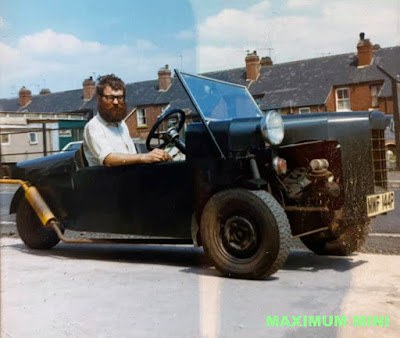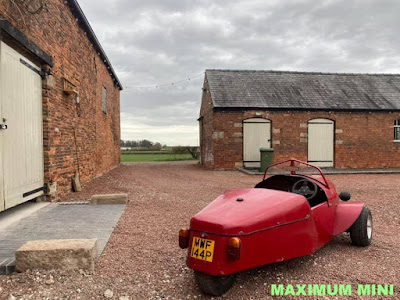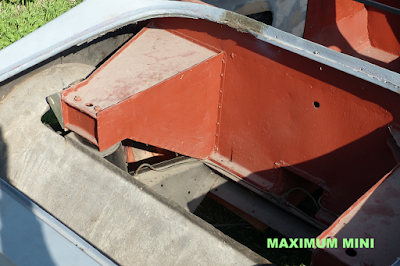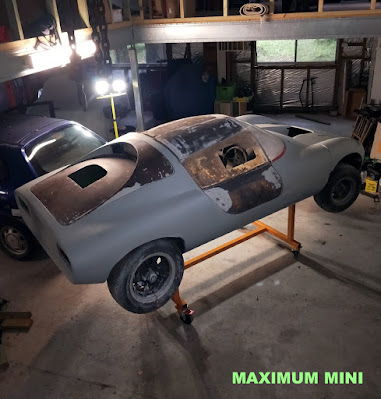Wednesday, 31 March 2021
Mosquito found in a barn
Tuesday, 30 March 2021
Mystery Mini Derivative (73)
Monday, 29 March 2021
JS2 three-wheeler back to creator's son
There are a lot of Mini based three-wheelers coming out of the woodwork and I'll share them with you this week. The kick-off is provided by Scotsman and historic racer Ewen Sergison, who shared the lovely story of his dad's Special, which he found back just a couple of days ago. He wrote:
"In 1976 my dad wanted out the house as his new born son (me) would not stop crying! He stopped shaving, locked himself in the garage and built and then registered the JS2 (what JS1 was I don’t know unless it was me). Today I bought it back! Most of my cars have girls names but at the moment “IT” is back! V5c still says make: JS, model: JS, chassis number: JS2. My earliest memories were getting splinters in my legs from it’s plywood seat and dad showing me how he could do stoppies in it! Dad my old man invent stoppies? An emotional day to actually drive it! Thanks to Barry and Ray for selling it back to me! Means the world!"
Well done Ewen, hope you will enjoy the JS2 for many years to come!
More recent three-wheeler stories about some great family provenance here and here.
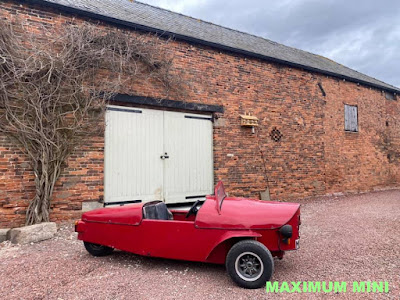
Friday, 26 March 2021
Found and for sale: genuine Cox GTM
When I heard of a Cox GTM that had been in storage since 1993 in Belgium I had to know more. Two weeks and lots of e-mails later the car is now at my home, parked next to the Le Mans Mini Marcos.
Unlike so many GTMs this really is a Cox with the flat bonnet and the welded 'cow horns' at the back to hold the rear chassis, the later (Heerey) GTMs having a box section there. Oddly it does have the two-part boot lid, which I believe was introduced later, but then this may have been retro-fitted. Somebody, at some point, started a restoration on the car and both the chassis as well as the body have been worked on. The previous owner's dad bought it as you can see it here with the plan to turn it into an autotest car, but it never happened. He did buy a brand new laminated windscreen and Perspex rear screen, which came with the car, as well as the gear linkage mechanism and a few more parts.
Unfortunately there is no registration or further paperwork with it, although I think it may well have been on the road before work started. I hope to find out more about that, but am looking for a new home for this car now. Contact me when you are interested. The ad is here.
UPDATE 29 March: I've added a few pictures of the gear linkage and screens that are included. Also found a bonnet badge and some more stuff. I may be tempted to add that with the car, too!
UPDATE 6 April: The car is now sold to a highly valued reader of Maximum Mini in the UK.
Tuesday, 23 March 2021
One owner since 1969: Banshee is now for sale
Thursday, 18 March 2021
Jack Fisher's Specials make it to print
Several of you tipped me off about a new book by Peter Speakman and Kenny Baird, which came out last month, describing the doings and dealings of Scotsman Jack Fisher. Fisher famously ran a garage and dealership in Edinburgh and competed in a great number of cars, the majority of them designed and built by himself. From his own memory there were 22 of them, and they are all described in this lovely little book, some in a few lines only; others more extensively. You have probably heard of the Mini based Fisher Spyder (here) and Fisher GT ('Maximum Mini Find of the Year 2020' - more here) but there were clearly more than these alone!
Like Colin Chapman, Trevor Wilkinson, Eric Broadley and Jem Marsh - to name just a few - Fisher, too, started small with an Austin 7 Special, but later cars also used Fiat, MG, Riley, Jaguar, Alfa-Romeo and Lancia power. The Mini based GT and Spyder are relatively extensively described here with some new information and a few new pictures (to me, at least). But I was also surprised to read there were plans to come up with a Formula Junior car using a mid-mounted Mini engine/gearbox as well, and that as early as 1959! From the book: "This was advanced thinking for the time, as FJ cars of this period were mainly front engined. The project was subsequently aborted as Jack felt the rapid development of the Ford FJ engine would leave the BMC unit uncompetitive." Now that would have been a novelty!
Apart from the 22 cars there is a chapter devoted to competition history and one to the Fisher Specials as they are today. The Fisher GT was originally painted silver - a colour photograph taken back in 1965 is there to prove it - and it will be repainted in that hue, too. Other then so many books repeating old information and pictures, this is just about the opposite. It's small and only for the happy few who know about these cars or are interested in them, but it will be right up their street, too, as it is made with genuine enthusiasm for these cars. It's 120 pages in a small format but no doubt worth the 20 pounds including postage and packing. Buy it here.













